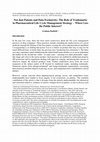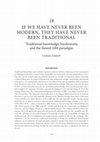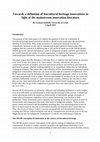Papers by Graham Dutfield
The book is as the title states a critical history of the industry since 1880 which is the time I... more The book is as the title states a critical history of the industry since 1880 which is the time I trace its beginnings to. The first chapter can be downloaded here and the book can be ordered from Amazon and other online bookstores, including the publisher: https://www.worldscientific.com/worldscibooks/10.1142/11889 - for 30% discount use this code when ordering: WSPHARMIND30 (valid until 31 Jan. 2021)

Published in Intellectual Property Law and the Right to Health: A History of TRIPS and Access to Medicine (Srividhya Ragavan & Amaka Vanni eds.), 2020
In the past few years there has been much controversy about the lifecycle management practices of... more In the past few years there has been much controversy about the lifecycle management practices of drug companies. These include extending the market power of a given medicine beyond the lifetime of the first patent covering the active pharmaceutical ingredient (“evergreening”); or shifting that power over to a follow-on product that may or may not be much different from, or better than, the previous one (“producing line extensions”). Sometimes in the latter case it may entail withdrawing the initial brand-name product so as not to undermine the market for the second one whilst – in some cases – carrying over other protectable ‘signs’ like shape and colour to the newer product. Such practices are enabled by intellectual property protection as well as by regulations dealing with approval, naming and pricing that concern, or that otherwise impact, the medical products trade. Current concerns about pharmaceutical pricing, access and competition issues have tended to focus largely if not exclusively on patents. The scholarly contribution of this article is that it diverges from the tendency to discuss each intellectual property (IP) right in isolation, most commonly the right under analysis being patents. That this is so frequently done is not unjustified. But trademarks now need more than ever to be part of the discussion, and explaining why this is so is the main claim to originality of this article.

Achieving Sustainable Development Goal 2: Which Policies for Trade and Markets? edited by ICTSD, Geneva, pp 61-77, 2018
This paper from a multi-author volume by ICTSD (available on its website) seeks to clarify the sc... more This paper from a multi-author volume by ICTSD (available on its website) seeks to clarify the scale of the challenges facing the international community with a view to identifying ways that governments and international organisations, cooperating or working separately, can advance SDG 2.5 through trade and market-related actions and policies. Trade can potentially help by encouraging increased productivity and incomes for small producers, facilitating access to and circulation of plant genetic resources and relevant technologies, increasing employment in rural areas, and providing new opportunities for value addition. None of this automatically arises from trade but rather requires the right actions to be adopted. International forums for negotiation on trade and related matters, multilateral institutions, and agreements relevant to trade, as well as the shifting and evolving architecture of preferential trade agreements, create “policy spaces” to engage in meaningful dialogue on this and other SDGs. International cooperation is essential, but governments also have broad freedoms to operate independently, and it is important to identify where opportunities lie and how they can act upon them.

Routledge Handbook on Biodiversity and the Law, Edited by Charles McManis & Burton Ong, 2018
The conventional wisdom behind the TK-related aspects of the ‘ABS+plus IP’ model embodied by the ... more The conventional wisdom behind the TK-related aspects of the ‘ABS+plus IP’ model embodied by the Convention on Biological Diversity and the Nagoya Protocol is fundamentally flawed. This chapter identifies four main reasons why such approaches generally fail to provide solutions that are fair, equitable and efficient. We call these: (i) the hybrid nature of knowledge systems; (ii) the problem of origin and attribution; (iii) the overregulation and corporatization tendency; and (iv) the exchange value ‘distraction’. In the meantime, traditional knowledge is being lost worldwide. International solutions are no substitute for legal and policy initiatives giving more power to local people to make their own decisions. However, whether they elect to retain, abandon, mix or transform their local biodiversity-friendly livelihoods and customary practices is ultimately for them to decide.

Washburn Law Journal, 2019
National and regional legal and regulatory frameworks have been put in place to implement provisi... more National and regional legal and regulatory frameworks have been put in place to implement provisions of the 1992 Convention on Biological Diversity (CBD) on access to genetic resources and traditional knowledge and benefit sharing from their use. However, few meaningful benefits from access and benefit sharing (ABS) frameworks have been secured by groups holding traditional knowledge associated with genetic resources (TKGR) or by other developing country stakeholders. Our hypothesis is that ABS frameworks can only work effectively and equitably in a world in which the geographies of genetic resources and of associated traditional knowledge are sufficiently static, and where the norm is for there to be unequivocal linkages between knowledge-holding individuals and groups, biological matter and information of actual or potential human use associated with this knowledge, and specific and identifiable places. We argue that by and large this is not the case. We show how a historical geography perspective informed by anthropology and ethnoecology is extremely useful in separating those instances where benefit sharing with a specific group or community is due and is practicable, and those probably far more common situations where either no benefits are due, or else such benefits must be distributed using existing norms by means of a multilateral mechanism. Our skepticism about the current tendency to focus narrowly either on ABS frameworks leads us to the view that a human rights framework that we construct based on existing international instruments offers a more robust, comprehensive and culturally sensitive legal structure that addresses the legitimate concerns of indigenous peoples that can be applied both within and – which is probably preferable – outside of conventional ABS frameworks and intellectual property-related norms.

Journal of World Intellectual Property, 2017
There is an emerging international regime complex concerning traditional knowledge (TK). Debate c... more There is an emerging international regime complex concerning traditional knowledge (TK). Debate continues on what form legal protection should take including how benefits from commercial use ought to be shared. This article considers how far progress is feasible. It makes three related claims. First, dominant in policy debates has been a tendency to position “tradition” in direct and binary opposition to “modern”. We show how this is ahistorical, reinforcing misconceptions regarding the nature of TK, and its relationship to other knowledge systems. It also tends to discourage possibilities for mutually advantageous collaborations based on respect for local norms regulating access, control and ownership. The second claim is that many TK advocates, by misconceiving it this way, are too expansive in terms of the knowledge that they demand the proposed international regimes should cover. This precludes possibilities for policy coherence. The third is that the access and benefit sharing measures envisaged by the Convention on Biological Diversity tend to downplay the social and cultural value of TK for holders and their communities themselves. This matters because of TK's significance to local people's lives, which is likely to outweigh potential monetary value that may arise from its translation into biotechnological knowledge inputs.

Health Economics, Policy & Law, 2017
This article reviews current trends in patent claims regarding personalised, stratified and preci... more This article reviews current trends in patent claims regarding personalised, stratified and precision medicine. These trends are not particularly well understood by policymakers, even less by the public, and are quite recent. Consequently, their implications for the public interest have hardly been thought out. Some see personalised and other secondary drug patent claims as promoting better targeted treatment. Others are inclined to see them as manifestations of 'evergreening' whereby companies are, in some cases quite cynically, trying to extend market monopolies in old products or creating new monopolies based on supposedly improved versions of such earlier drugs. The article claims that the relaxation of 'novelty' is a privilege unavailable to inventions in other fields and that on balance the patent system does privilege this industry and that no adequate case has yet been made thus far to prove the public benefits overall.
This is the unedited draft of a book chapter to be published in 2018 in: Claudy op den Kamp & Dan... more This is the unedited draft of a book chapter to be published in 2018 in: Claudy op den Kamp & Dan Hunter, eds, A HISTORY OF INTELLECTUAL PROPERTY IN 50 OBJECTS. Cambridge University Press.
This paper concerns ways to enable indigenous peoples to market their products through labelling ... more This paper concerns ways to enable indigenous peoples to market their products through labelling schemes. (Written with Krystyna Swiderska, Aroha Mead, and Alejandro Argumedo.). Full citation: K Swiderska, A Mead, G Dutfield, and A Argumedo, "Designing a labelling system for biocultural heritage-based products". POLICY MATTERS 21, 140-8, 2016
This article offers a critical perspective on the academic and political debate on traditional kn... more This article offers a critical perspective on the academic and political debate on traditional knowledge and intellectual property in light of the author's 20 years' engagement in the subject. In spite of legal instruments like the CBD and the Nagoya Protocol, the article argues that progress has been disappointing. In part this is due to failure to understand how industry uses biodiversity, excessive hype concerning the pharmaceutical value of TK, unwillingness to confront the unavoidable complexity that regulation needs to overcome, and especially the reluctance to cede power to TK holding individuals, groups and peoples including respect for their customary laws.

The Manchester Manifesto raises legitimate concerns about the ownership of science, casting a cri... more The Manchester Manifesto raises legitimate concerns about the ownership of science, casting a critical light on the how the pursuit of profit and the aggressive assertion of IP-based business models can run counter to public interest goals, produce drag effects on innovation, block flows of scientific information, and prevent access to socially-beneficial products, such as medicines for the poor. However, the Manifesto is a disappointment, especially given the high standing of those involved. It may also threaten to undermine the credibility of those of us who do feel we have very sound reasons for finding the current patent and copyright systems and their usage by business to be unbalanced, unfair, and detrimental to scientific openness and to the development of applied science that is oriented towards public interest goals.
citing any evidence, a word that barely features at all in the proposition paper and
is nowhere to be found in the Manifesto itself.

The purpose of this short paper is to address the question of how far a definition of biocultural... more The purpose of this short paper is to address the question of how far a definition of biocultural heritage-based innovation should or should not be based upon the mainstream thinking on innovation. Most of the economics of innovation literature focuses on corporations, business sectors and on national policy and regulatory frameworks. Nonetheless, the paper argues that this literature is relevant. First, it confirms that innovations do not have to be novel in any strict sense to be “innovations”. Second, innovations are seen as comprising mixtures of insights, practices and natural products and artefacts, and tend to be generated by groups, whether working together or in competition, rather than by individuals working in isolation. This seems like a fair reflection of how innovations are generated within indigenous communities. However, one must not lose sight of a number of differences too, as the paper will show.
eds): Making and unmaking intellectual property: Creative production in legal and cultural perspe... more eds): Making and unmaking intellectual property: Creative production in legal and cultural perspective. This book review essay was accepted for publication in the Springer journal Metascience. Unfortunately I was unable to accept the publisher's conditions for publication: that, either (a) I assign my copyright; or that (b) I grant the company permission (by authority I do not in fact have) to bill my university library for the sum of €2,200 to make the essay open access. Since option (a) is morally unacceptable and (b) is the same and in any case unavailable, I have decided to make the article freely open access whilst retaining my copyright including moral rights of authorship and integrity.
This article discusses the issue of credit and attribution in relation to Novartis's highly succe... more This article discusses the issue of credit and attribution in relation to Novartis's highly successful medicine, Glivec, a patent on which was the subject of a controversial court case in India.
This chapter is about science, patent law and the use of language that supports the extension of ... more This chapter is about science, patent law and the use of language that supports the extension of patent claims ever deeper into the realms of nature. By language I refer in particular to the use of figures of speech, terminologies and epistemologies that both express and support powerful explanatory and justificatory conceptual systems. Undoubtedly, chemical, informational and mechanistic ways of understanding life have all been enormously helpful to scientists, as are the metaphors and analogies which frame their verbal and written forms of expression. The point of the chapter is not to undermine them, but to examine critically what implications they have for patent law and policy, in particular their consequences for the positioning of boundaries between the patentable and the unpatentable. NB These are uncorrected proofs.
“Disclosure of origin” has become a collective term for certain requirements to be incorporated i... more “Disclosure of origin” has become a collective term for certain requirements to be incorporated into patent law. These requirements vary widely in terms of the weight and nature of the legal, administrative or informational burdens placed on patent applicants and owners. Accordingly, it is convenient to describe three types of disclosure requirement.










Uploads
Papers by Graham Dutfield
citing any evidence, a word that barely features at all in the proposition paper and
is nowhere to be found in the Manifesto itself.
citing any evidence, a word that barely features at all in the proposition paper and
is nowhere to be found in the Manifesto itself.
In today's global marketplace, no stone goes unturned. Where there is commercial value, there are profits to be made. However, as entrepreneurs scour the world in search of new commodities, a voice of dissent is growing and striving to be heard. That voice belongs to the world's indigenous peoples, and it is voice that has been ignored long enough.
In Beyond Intellectual Property, authors Darrell A. Posey and Graham Dutfield listen and respond to this voice. They offer sound and reasonable advice on how indigenous peoples and local communities worldwide should approach and deal with the myriad of issues surrounding intellectual property and traditional resource rights.
For indigenous peoples' groups, activists and policymakers in intellectual property, and all those concerned with the preservation of our planet's biological and cultural diversity, Beyond Intellectual Property provides an invaluable and eye-opening look into one of the most provocative and explosive issues of this century and likely the next: the patenting of life.
L’« ère des hormones », de 1900 aux années 1960, a été une période intense pour l’industrie pharmaceutique quant à la mondialisation et à la concurrence à l’intérieur et au-delà des frontières nationales. Les brevets et les stratégies liées aux brevets étaient des éléments essentiels de ce processus d’évolution. Les hormones sont des transmetteurs chimiques produits par les organismes vivants, dont les humains. Elles se retrouvent dans un large éventail de produits, notamment les médicaments anti-inflammatoires et les contraceptifs. Dès la découverte du potential commercial des hormones, l’industrie a dû relever le défi de les produire en grande quantité. Évidemment, il s’agissait d’une question scientifique, mais touchait éaglement au monde des affaires et de la propriété intellectuelle. Les modes de production - extraction ou synthèse - des hormones se sont avérés tous les deux également capables de produire de la matière brevetable. Tel était le cas, même lorsque la matière était basée sur une substance produite par un organisme ou une copie produite en laboratoire. Cette situation a créé un précédent historique en ce qui a trait à l’octroi de brevets pour les « choses naturelles », comme les antibiotiques, les gènes, les cellules, les microbes, les plantes et les animaux. Par conséquent, le fait de breveter des hormones nous a permis de réaliser que les produits biotechnologiques peuvent être des inventions brevetables.